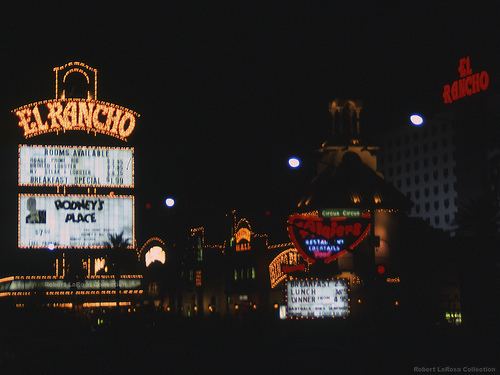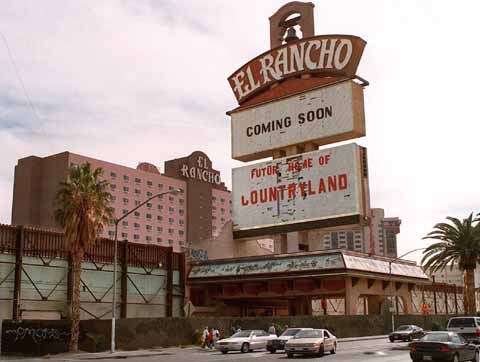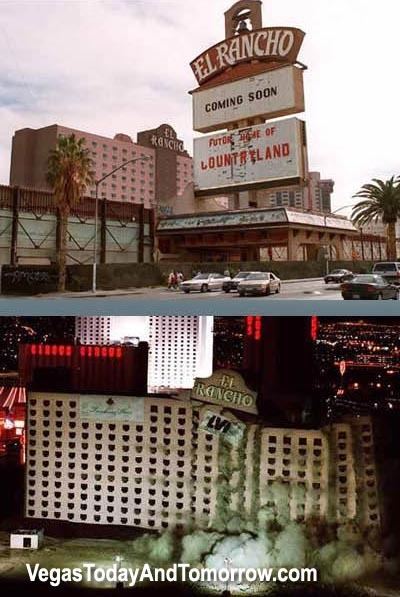Location Winchester, Nevada Theme Western Closed 6 July 1992 Total gaming space 8,361 m² | Opening date September 2, 1948 No. of rooms 1,000 Opened 2 September 1948 Number of rooms 1,000 | |
 | ||
Address 2755 Las Vegas Blvd South Closing date July 6, 1992; 24 years ago (July 6, 1992) Similar El Rancho Vegas, Dunes, New Frontier Hotel and, Stardust Resort and Casino, Silver Slipper | ||
El rancho hotel and casino implosion 2015 pacific town 6 23 2015 making room for a cp parking lot
The El Rancho Hotel and Casino (formerly known as The Thunderbird and The Silverbird) was a hotel and casino that operated on the Las Vegas Strip in Winchester, Nevada from 1948 to 1992.
Contents
- El rancho hotel and casino implosion 2015 pacific town 6 23 2015 making room for a cp parking lot
- Thunderbird 1948 1976
- The Silverbird 1976 1982
- El Rancho 1982 1992
- Later years and demolition 1992 2000
- Algiers Hotel
- In media
- References

After its closure, the El Rancho sat vacant for eight years while two companies made several attempts to reopen or replace the resort, which was eventually demolished in 2000, after a news report found the decrepit buildings to be in violation of health and safety regulations.

The site later became part of the land used for the un-opened Fontainebleau Resort Las Vegas.
Thunderbird (1948-1976)

On September 2, 1948, the Thunderbird Hotel was the fourth resort to open on the Las Vegas Strip. The resort was built by developer Marion Hicks and owned by Lieutenant Governor of Nevada Clifford A. Jones. The resort had a Native American theme and featured portraits, a Navajo-based restaurant, the only bowling alley ever on the Strip, and a showroom. In 1955, articles surfaced in the Las Vegas Sun saying that Meyer Lansky and other underworld figures held hidden shares in the hotel.

In 1964, the casino was purchased by Del Webb for $10 million. He ran the resort until 1972, when he sold it to Caesars World, owner of Caesars Palace, for $13.6 million. A $150-million, 2,000-room resort called the Mark Anthony was planned for the site, but Caesars was unable to find financing, and sold the property four years later to banker E. Parry Thomas at a loss of $5.7 million. Thomas later sold it to Major Riddle, owner of the Dunes Hotel, who renamed the resort as the Silverbird in 1976.

The Thunderbird has the distinction of being the resort where singer Rosemary Clooney made her first appearance in Las Vegas in 1951, and where Judy Garland made her final Vegas appearance in 1965.
The Silverbird (1976-1982)
The Silverbird opened on January 1, 1977. By 1980, the resort had 400 hotel rooms. In 1981, Major Riddle sold the resort to Ed Torres for $500,000. Torres also owned the Aladdin Hotel and Casino. Torres renamed the Silverbird to the El Rancho, named after the nearby El Rancho Vegas, which burnt down in 1960.
El Rancho (1982-1992)
In 1982, Torres hired casino architect Martin Stern, Jr. to add a new entrance and expand the hotel, by adding a 13-story 600-room hotel tower, for a total of 1,000 rooms. On August 31, 1982, the El Rancho opened its doors. According to the Gaming Control Board, Torres had close ties with some of the most notorious crime characters of the time. However, this did not restrict him from owning a gaming license. Rodney Dangerfield opened the "Rodney's Place" comedy club inside the El Rancho in 1982. In 1987, Stern was hired again to expand the hotel and casino.
The El Rancho closed on July 6, 1992.
Later years and demolition (1992-2000)
By October 1993, Las Vegas Entertainment Network Inc. (LVEN), a Los Angeles-based television production company, had plans to redevelop the resort and reopen it in 1994 as El Rancho's Countryland USA. The new resort would have included a family-oriented theme park with country-style entertainment and attractions. LVEN also planned to construct two 20-story hotel towers meant to resemble a gigantic pair of Western-style boots. The new towers would have brought the El Rancho up to a total of 2,001 hotel rooms. LVEN purchased the property in November 1993, for $36.5 million.
By January 1994, LVEN planned to open El Rancho's Countryland USA with its own 24-hour cable television channel based inside the new resort, which would have housed facilities for production and broadcasting. The channel would have promoted events at the resort, as well as other resorts. LVEN had also planned to add a country-themed shopping mall and a rodeo production facility to the new resort. Construction of the new hotel towers was delayed because of a lack of financing. In October 1994, LVEN received $35 million from a Dallas investment bank for construction of the towers. At that time, LVEN had also planned to launch the Las Vegas Country Television Network, which would have featured country-western entertainment and other shows on the Las Vegas Strip.
In January 1996, Orion Casino Corporation–a newly formed Nevada subsidiary of International Thoroughbred Breeders (ITB), a New Jersey racetrack operator founded by notorious penny-stock operator Robert E. Brennan–purchased the El Rancho from LVEN for $43.5 million. The following month, ITB announced plans to demolish the El Rancho and construct Starship Orion, a $1 billion hotel, casino, entertainment and retail complex with an outer space theme, covering 5.4 million square feet. The resort was to include seven separately owned casinos, with each one being approximately 30,000 square feet. Each potential casino owner was to contribute up to $100 million to own and operate a casino within the complex. The complex would have also included 300,000 square feet of retail space, as well as 2,400 hotel rooms and a 65-story hotel tower. ITB hoped to begin construction later that year (1996), with a planned opening date of April 1998.
In an agreement with LVEN, ITB was to come up with financing for the project, with a deadline of October 25, 1996. If ITB were unsuccessful, LVEN had an option to seek alternative financing for a less-expensive project, such as re-opening the El Rancho. A week before the deadline, ITB told LVEN that the Starship Orion project had not generated any financing from potential investors. ITB was pursuing other possible options for the property at that time. ITB and LVEN subsequently got into a dispute regarding control of the El Rancho. By January 1997, ITB had plans for a $100 million renovation of the El Rancho, which they planned to reopen as Countryland USA. The new resort would have included a 1,700-room hotel and a 100,000-square-foot casino. By February 1997, the two companies had settled their dispute, while the resort was expected to reopen in the first quarter of 1998. These plans did not materialize. By June 1999, a buyer was considering a purchase of the resort.
In December 1999, local news channel KVBC News 3 was granted access to the El Rancho after being invited by two unnamed workers. KVBC conducted and aired an investigation of the resort's structures. Asbestos and exposed wiring were reportedly found throughout the buildings, as well as corroding chemicals which covered the floors. Rats and bugs were found to be inhabiting the resort. While most of the structures were decomposing, another section of the El Rancho was found to have been renovated with working slot machines, which had been lent to the owners by Bally Gaming three years earlier to showcase to potential investors for the Countryland USA project. After the investigation aired, the property's owners were fined for health and safety violations by the local building and fire departments, as well as the Occupational Safety and Health Administration.
In February 2000, Turnberry Associates acquired a six-month option to purchase the El Rancho, which Turnberry described as "an eyesore". Turnberry was in the process of developing Turnberry Place, a series of luxury high-rise condominium towers directly east of the El Rancho. In May 2000, Turnberry purchased the resort from ITB for $45 million.
On October 3, 2000, the resort's last remaining structure, the 13-story hotel tower, was imploded with 700 pounds of explosives in front of 2,000 spectators. After the implosion, 10,000 pounds of concrete from the demolished resort was used by the Southern Nevada Water Authority and the Las Vegas Wash Coordination Committee to stabilize the Las Vegas Wash.
The site later became part of the land used for the un-opened Fontainebleau Resort Las Vegas.
Algiers Hotel
In 1953, the Thunderbird opened the 110-room Algiers Hotel, a sister property to deal with an overflow of guests. The hotel included a lounge. The Algiers was closed in August 2004, and had been demolished by March 2005, to make way for Krystle Sands, a $400 million, 45-story condominium/hotel tower planned to be constructed on the 3.6-acre property. The Krystle Sands project was cancelled in March 2005. The property is currently occupied by a portion of the Fontainebleau Resort.
In media
The Thunderbird sign was featured in the 1975 Sanford and Son episode, "Earthquake II." The El Rancho sign is briefly featured in the 1997 film, Con Air. The El Rancho's demolition and implosion was recorded and featured in the 2004 National Geographic Channel documentary, Exploding Las Vegas. The Casino was also the setting of "Fever", an episode from the first season of the Twilight Zone.
